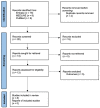Utilization of Mirror Visual Feedback for Upper Limb Function in Poststroke Patients: A Systematic Review and Meta-Analysis
- PMID: 37987295
- PMCID: PMC10661272
- DOI: 10.3390/vision7040075
Utilization of Mirror Visual Feedback for Upper Limb Function in Poststroke Patients: A Systematic Review and Meta-Analysis
Abstract
Mirror visual feedback (MVF), a noninvasive treatment method, is attracting attention as a possibility to promote the recovery of upper limb function in stroke patients. However, the cognitive effects of this therapy have received limited attention in the existing literature. To address this gap, we conducted a systematic review and meta-analysis to investigate the relationship between upper limb function and cognition in stroke patients and to evaluate the effect of MVF on improving upper limb function. A comprehensive search was performed on the Embase, MEDLINE, and PubMed databases to identify original articles and clinical studies published between 2013 and 2022. Qualitative analysis was performed using the Cochrane Risk of Bias tool, and in the quantitative analysis, a random-effects model was used as the effect model, and standard mean difference (SMD) was used as the effect measure. Eight studies that met the inclusion criteria were entered in the analysis. Data extraction included an assessment tool for upper extremity function. Results of the quantitative analysis demonstrate that MVF was effective in improving upper extremity function in stroke patients (SMD = 0.94, 95% CI 0.69 to 1.20). In conclusion, this systematic review and meta-analysis provides evidence supporting the effectiveness of MVF in improving upper limb function in stroke patients. However, further studies are needed to investigate the cognitive effects of MVF and elucidate the underlying mechanisms.
Keywords: cognitive function; mild cognitive impairment; rehabilitation; virtual reality.
Conflict of interest statement
The authors declare no conflict of interest.
Figures


Similar articles
-
Reflections on mirror therapy: a systematic review of the effect of mirror visual feedback on the brain.Neurorehabil Neural Repair. 2015 May;29(4):349-61. doi: 10.1177/1545968314546134. Epub 2014 Aug 26. Neurorehabil Neural Repair. 2015. PMID: 25160567 Review.
-
Folic acid supplementation and malaria susceptibility and severity among people taking antifolate antimalarial drugs in endemic areas.Cochrane Database Syst Rev. 2022 Feb 1;2(2022):CD014217. doi: 10.1002/14651858.CD014217. Cochrane Database Syst Rev. 2022. PMID: 36321557 Free PMC article.
-
Effectiveness of Using Virtual Reality-Supported Exercise Therapy for Upper Extremity Motor Rehabilitation in Patients With Stroke: Systematic Review and Meta-analysis of Randomized Controlled Trials.J Med Internet Res. 2022 Jun 20;24(6):e24111. doi: 10.2196/24111. J Med Internet Res. 2022. PMID: 35723907 Free PMC article. Review.
-
Brain-machine interface-based training for improving upper extremity function after stroke: A meta-analysis of randomized controlled trials.Front Neurosci. 2022 Aug 3;16:949575. doi: 10.3389/fnins.2022.949575. eCollection 2022. Front Neurosci. 2022. PMID: 35992923 Free PMC article.
-
Non-invasive brain stimulation associated mirror therapy for upper-limb rehabilitation after stroke: Systematic review and meta-analysis of randomized clinical trials.Front Neurol. 2022 Jul 19;13:918956. doi: 10.3389/fneur.2022.918956. eCollection 2022. Front Neurol. 2022. PMID: 35928134 Free PMC article.
Cited by
-
Distinct and additive effects of visual and vibratory feedback for motor rehabilitation: an EEG study in healthy subjects.J Neuroeng Rehabil. 2024 Sep 12;21(1):158. doi: 10.1186/s12984-024-01453-3. J Neuroeng Rehabil. 2024. PMID: 39267092 Free PMC article.
References
Publication types
Grants and funding
LinkOut - more resources
Full Text Sources
Miscellaneous

